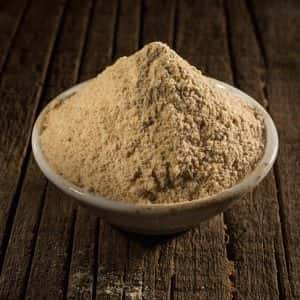
Most common everyday health concerns trouble people around the world. They result from the way the human body works. Everyone has to eat, for example, so digestive difficulties, including smelly gas, are part and parcel of the human condition.
Some cultures have found clever ways to deal with this problem, however. We always appreciate learning about them, and we were glad to hear from this reader.
Freedom from Flatulence:
Q. I have been reading about the problems some of your readers have with flatulence, and I would like to put forward a solution from an Indian kitchen. Placing a generous pinch of asafoetida (“hing”) powder on the tongue and washing it down with water removes flatulence in a matter of hours.
A. Asafoetida is a resin from the underground portions of the plant Ferula asafoetida. It has been referred to in English as stinking gum or devil’s dung, suggesting its strong unpleasant odor.
In traditional Indian herbal medicine, asafoetida is used for lung conditions as well as digestive disorders. It contains compounds that prevent blood clotting and lower blood pressure (Pharmacognosy Reviews, July 2012).
We understand that Indian cooks add hing to dishes that might otherwise cause flatulence and that it is valued as a culinary spice. Apparently it also has antifungal and anti-inflammatory activity and can be used to lower blood sugar (Journal of Ethnopharmacology, Mar. 8, 2011).
Although there are other ways to control gas or ease flatulence, hing is not well known in the US. Here, people are more likely to use peppermint or a drugstore remedy such as activated charcoal. In the Hispanic community, epazote (Dysphania ambrosioides) or yerba buena (Mentha citrata) are both popular.
Keeping a “Fart Chart:”
It can be very helpful to keep a diary of foods, medicines and supplements consumed and symptoms of flatulence to discover what is causing the trouble. Avoiding the worst culprits to prevent the problem can go a long way towards providing relief.
Home Remedies for Flatulence:
We have been collecting home remedies for gas for more than 40 years. Here are some suggestions from visitors to this website that make sense to us:
Angostura Bitters:
Bartenders are the experts when it comes to bitters. That’s because they have been using the distinctive flavor of bitter herbs in mixed drinks like Manhattans and Old Fashioneds for a very long time. Ingredients may include quinine (from cinchona bark), wormwood, orange peel and gentian. Angostura bitters originated in Venezuela in 1824 and is one of the more famous brands. Like Swedish bitters, these concoctions have been used to treat digestive distress for centuries.
A waitress wrote to us years ago:
“Has anyone suggested Angostura bitters for gas? When I was a waitress and had that problem, someone suggested a teaspoon in a glass of 7-Up or just club soda. It worked immediately.”
The label on a bottle of Angostura bitters actually suggests one to four teaspoonfuls after meals for flatulence.
J.N. offered this testimonial:
“Angostura bitters works great for me for gas and heartburn. It took me a while to find it. It was in the liquor department of my grocery store.”
Pepto-Bismol:
Most people think about this familiar pink liquid as an aid for heartburn. There is, however, research to suggest the ingredient in Pepto-Bismol (bismuth subsalicylate) can be helpful against smelly gas.
M.K. suggested P-B tablets:
“Here’s a good one. Take a Pepto-Bismol tablet every day. Helps absorb much of that smelly gas. It will turn your stool black, but no harm in one a day. I check with my doctor about safety and he said “no problem.” Pepto tabs also aid in keeping bad bacteria at bay when traveling.”
We are not so comfortable recommending a dose of Pepto daily. The salicylate has aspirin-like activity and might interact with a number of other medications. It is also possible to overdose on bismuth. We would reserve this remedy for occasional use and follow the dosing instructions on the label.
Beano:
We had an opportunity to meet the inventor of Beano many years ago. Alan Kligerman is a fascinating character who came up with the idea behind Beano. It is a dietary supplement containing the enzyme alpha galactosidase, made from the fungus Aspergillus niger. It helps break down hard-to-digest sugars in beans and vegetables like cabbage and cauliflower. Although not perfect, it does seem to make a big difference for a lot of people.
Laverne says:
“I think Beano is natural. It has an enzyme in it. It says to chew or swallow 2-3 tablets right before your first bite of a problem food. I think it has helped me.”
B.A. adds:
“Beano works for me! Natural or not, I’m not asking any questions!”
We received this question a while back:
Q. At a church potluck dinner a friend served chili and then passed around Beano to prevent flatulence. Is it safe for children and does it really work?
Our answer: A study in the journal BMC Gastroenterology (Sept. 24, 2013) demonstrated that alpha-galactosidase reduced gas output in children without causing complications. The researchers concluded:
“Although larger and longer trials are needed to confirm this result, α-galactosidase seems to be a safe, well tolerated and effective treatment for gas-related symptoms in the pediatric population.”
If you would like to learn more about strategies to control gas, we recommend our Guide to Digestive Disorders.
1/14/19 redirected to: https://www.peoplespharmacy.com/articles/can-you-use-activated-charcoal-to-fight-flatulence/

